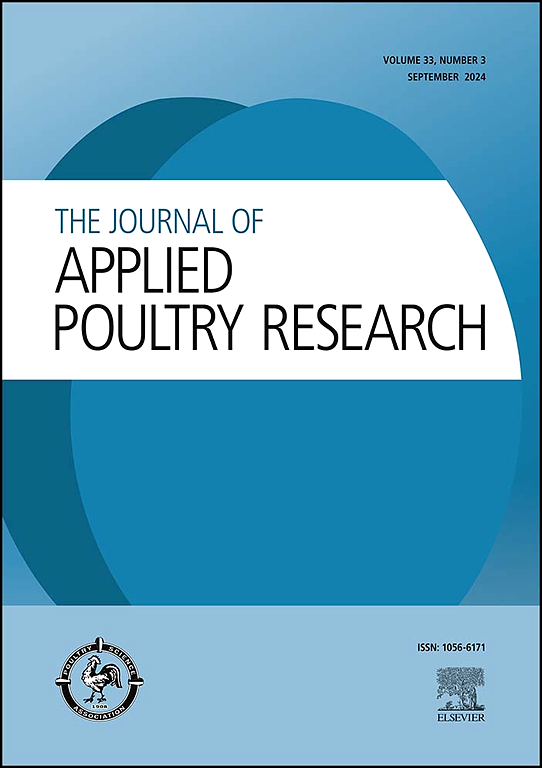Comparison of application rate of three commercial litter amendment products on litter pH, ammonia volatilization, and broiler paw scores during the brooding period
IF 2
3区 农林科学
Q2 AGRICULTURE, DAIRY & ANIMAL SCIENCE
引用次数: 0
Abstract
The objective of this study was to evaluate the duration of effectiveness of 3 commercially available litter acidifying amendments during the brooding period when chicks were housed at either half- or whole-house stocking densities. The treatments included control pens with no litter amendment product applied, PLT® (Poultry Litter Treatment, Jones-Hamilton Co.) and Poultry Guard® (PG; C&S Chemicals) at 0.49, 0.61, and 0.73 kg/m2, and Al+Clear® A7 (A7; Chem Trade Logistics) at 0.81, 1.02, 1.22 L/m2. In Experiment 1, broiler chicks were housed at 0.08 m2/bd (whole-house density) and at 0.04 m2/bd in Experiment 2 (half-house density). Both experiments utilized used litter from a commercial broiler farm placed into 5 pens per treatment in an experimental poultry facility. In Experiment 1, broiler chicks were reared in the pens for 15 d while chicks were reared to d 10 in Experiment 2. Data collected included litter parameters of moisture and pH, ammonia flux and bird performance. In both experiments, the application of PLT and PG resulted in lower litter pH than A7. All treatments also reduced litter ammonia flux compared to control (P < 0.05) in both experiments. In both experiments, PLT maintained a lower ammonia release compared to the other treatments through the end of each experiment. No differences (P > 0.05) in litter moisture, BW or FCR were observed between treatments in either experiment. PLT and PG at the highest application rate did improve average paw quality scores at d 15 in Experiment 1. These data demonstrate that at both stocking densities the 3 litter amendment products evaluated were able to reduce litter pH and ammonia flux compared to control.
3种市售凋落物改良剂施用量对育雏期凋落物pH、氨挥发及肉鸡爪评分的影响比较
本研究的目的是评估3种市售的凋落物酸化剂在育雏期间的有效性持续时间,饲养密度分别为半舍和全舍。处理包括未使用垃圾处理产品的对照围栏,PLT®(家禽垃圾处理,Jones-Hamilton Co.)和Poultry Guard®(PG;C&S Chemicals)浓度分别为0.49、0.61和0.73 kg/m2, Al+Clear®A7 (A7;化学贸易物流)分别为0.81、1.02、1.22升/平方米。试验1和试验2分别以0.08 m2/bd(全舍密度)和0.04 m2/bd(半舍密度)饲养肉鸡。这两项试验都使用了一个商业肉鸡农场的废猪粪,在一个试验家禽设施中,每次处理放置在5个围栏中。试验1在栏内饲养肉鸡15 d,试验2在栏内饲养至10 d。收集的数据包括凋落物水分和pH值参数、氨通量和鸟类生产性能。在两个试验中,施用PLT和PG导致凋落物pH低于A7。与对照相比,所有处理都减少了凋落物氨通量(P <;0.05)。在两个实验中,与其他处理相比,PLT在每个实验结束时都保持了较低的氨释放。无差异(P >;各组凋落物含水率、体重和料重比差异均为0.05)。在试验1中,最高施用量的PLT和PG提高了15 d的平均爪质量分数。这些数据表明,在两种放养密度下,与对照相比,3种凋落物修正产品均能降低凋落物pH和氨通量。
本文章由计算机程序翻译,如有差异,请以英文原文为准。
求助全文
约1分钟内获得全文
求助全文
来源期刊

Journal of Applied Poultry Research
农林科学-奶制品与动物科学
CiteScore
4.10
自引率
10.50%
发文量
80
审稿时长
104 days
期刊介绍:
The Journal of Applied Poultry Research (JAPR) publishes original research reports, field reports, and reviews on breeding, hatching, health and disease, layer management, meat bird processing and products, meat bird management, microbiology, food safety, nutrition, environment, sanitation, welfare, and economics. As of January 2020, JAPR will become an Open Access journal with no subscription charges, meaning authors who publish here can make their research immediately, permanently, and freely accessible worldwide while retaining copyright to their work. Papers submitted for publication after October 1, 2019 will be published as Open Access papers.
The readers of JAPR are in education, extension, industry, and government, including research, teaching, administration, veterinary medicine, management, production, quality assurance, product development, and technical services. Nutritionists, breeder flock supervisors, production managers, microbiologists, laboratory personnel, food safety and sanitation managers, poultry processing managers, feed manufacturers, and egg producers use JAPR to keep up with current applied poultry research.
 求助内容:
求助内容: 应助结果提醒方式:
应助结果提醒方式:


